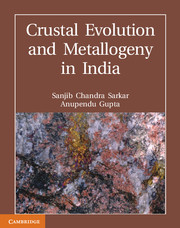Book contents
- Frontmatter
- Dedication
- Contents
- List of Figures
- List of Tables
- List of Plates
- Preface
- Chapter 1 Southern India
- Chapter 2 Central India
- Chapter 3 Eastern Ghat Belt
- Chapter 4 Eastern India
- Chapter 5 North-East India
- Chapter 6 Western India
- Chapter 7 The Himalaya
- Chapter 8 Crustal Evolution and Metallogeny in India: A Brief Review in the Context of the World Scenario
- References
- Index
- Plate Section
Chapter 3 - Eastern Ghat Belt
Published online by Cambridge University Press: 05 February 2014
- Frontmatter
- Dedication
- Contents
- List of Figures
- List of Tables
- List of Plates
- Preface
- Chapter 1 Southern India
- Chapter 2 Central India
- Chapter 3 Eastern Ghat Belt
- Chapter 4 Eastern India
- Chapter 5 North-East India
- Chapter 6 Western India
- Chapter 7 The Himalaya
- Chapter 8 Crustal Evolution and Metallogeny in India: A Brief Review in the Context of the World Scenario
- References
- Index
- Plate Section
Summary
Geology and Crustal Evolution
Introduction
The Eastern Ghat belt, geologically commonly referred to as the Eastern Ghat Mobile Belt (EGMB), expose granulite facies rocks over a curvilinear stretch of more than 1000 km length along the eastern coast of India (from Brahmini river basin, Orissa, in the north to Ongole, Andhra Pradesh, in the south). It represents one of the highly deformed and metamorphosed (at Ultra High Temperatures, UHT) Precambrian crustal segments of the Indian Shield. The belt is widest (∼ 300 km) in the north and thinner towards south (∼50 km), before tapering off beyond Ongole. Two major NW–SE trending rifts (grabens), Mahanadi in the north and Godavari in the south, dissect the belt (Fig. 3.1.1).
The EGMB is bordered by the Bastar and Dharwar cratons along the west and by the East Indian (Singhbhum–North Orissa) craton in the north. The location of the boundary and contact relationship of the granulite facies rocks of the EGMB with the lower grade cratonic components have remained debatable issues. However, most of the workers (Walker, 1902; Fermor, 1936; Pascoe, 1950; Ramakrishnan et al., 1998) identified a crustal scale thrust/shear contact along the western boundary, which roughly coincides with the linear zone of alkaline intrusives (Leelanandam, 1993; Rath et al., 1998) and is marked by a longitudinal ‘transition zone’ of amphibolite facies rocks (Nanda and Pati, 1989; Ramakrishnan et al., op. cit.).
- Type
- Chapter
- Information
- Crustal Evolution and Metallogeny in India , pp. 319 - 342Publisher: Cambridge University PressPrint publication year: 2012



